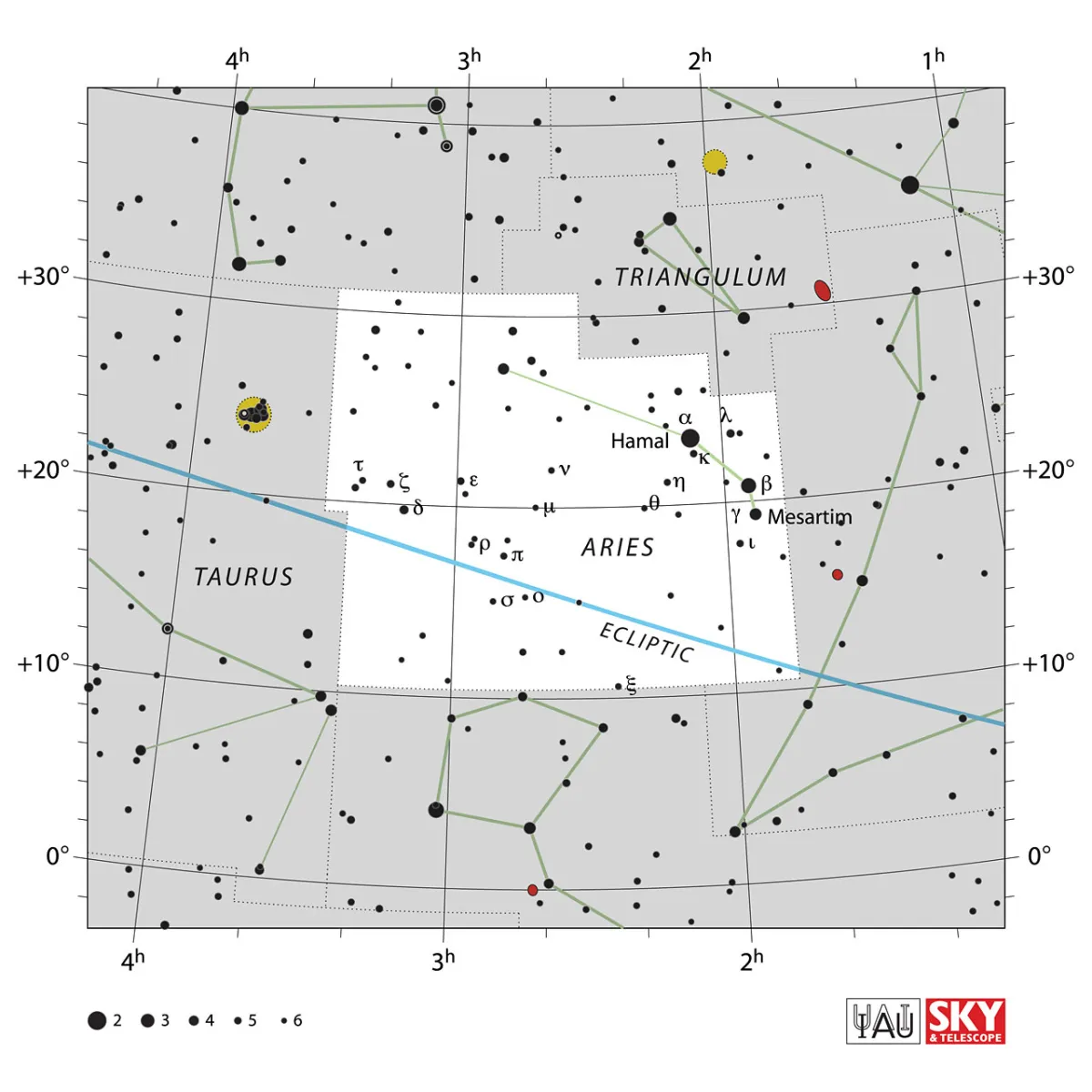Constellation Aries (Ram)

Properties
α, β and γ Arietis form a curved line and represent the horns of the ram. These stars are noticeable not because of their brightness, but because of their easy-to-remember pattern. Aries is to the west of the conspicuous seven stars, the Pleiades, followed by Taurus. The constellation area is 441 square degrees. The centre culminates at midnight on around October 20th. [9]
| α Ari | Hamal, Hemal, Hamul, Ras Hammel |
| β Ari | Sharatan, Sheratan, Al Sharatain |
| γ2 Ari | Mesarthim, Mesartim, "First Star In Aries" |
| δ Ari | Botein |
| IAU Name | Aries |
| IAU Genitive | Arietis |
| IAU Abbr. | Ari |
| English Name | Ram |
| Culmination at local midnight | 5 November |
| Season (Latitude +0.0°) | July … April |
| Right Ascension (J2000.0) | 01h 46m 37s … 03h 29m 42s |
| Declination (J2000.0) | +10° 21' 48" … +31° 13' 17" |
| Area | 441 deg2 |
| Neighbours (N↻) | Tri, Psc, Cet, Tau, Per |
Deep-Sky Object Descriptions
Catalogues
Mythology and History
The constellation Aries can be traced back to ancient times. Although it is rather an inconspicuous constellation, many legends have formed around it.
A legend comes from Greek mythology. There was Aries the ram with the golden fleece. Some say that this ram is the king of the gods himself: Zeus presumably took the form of a ram to escape persecution by the giants. [76]
In another legend, the ram was sent by Hermes - the messenger of gods and god of sleep and dreams - to save Prince Phrixus and his sister Helle. The two were the children of the cloud goddess Nephele and the ruler of Orchomenus. They were to be offered at the request of the Father's mistress, Ino. The ram tried to carry the prince and princess on his back through the air over land and sea - but Helle fell to death while Phrixus clung to the ram's wool and was able to save himself. The ram carried the prince to a land near the Black Sea. (The Dardanelles strait, between the Aegean and the Marmara Sea, was called the Hellespont because of this legend in ancient times.)

The ram then ordered Phrixus to sacrifice him to the gods and to take away his golden wool. Phrixus presented the fleece to King Aeetes, who hung it in a sacred wood, where it was guarded by a sleepless dragon. The golden fleece was so bright that it bathed the land in golden light at night.
The Golden Fleece was later associated with the voyage of the ship Argo, manned by Jason and his famous Argonauts - the heroes of Greek legend. They drove to Colchis to conquer the Golden Fleece. In the meantime, Aries has been given a place under the stars for his friendliness and generosity.
Perhaps the reason why the stars in the constellation Aries are so dark is that Aries lost its brilliant golden fleece before it was placed between the stars. [76]
The constellation for the Romans was Aries; Ovid called it Phrixea Ovis (sheep of Phrixos), others called it Portior Phrixi, Phrixi Vector (something like ferryman of Phrixos). After the golden coat colour it was called Ovis aurea and Ovis auratus.
At this point it should be noted that there used to be a constellation north of Aries that is no longer recognized today. The constellation was called Musca Borealis (Northern Fly). Other names were fly, Vespa (wasp, brake) and Apis (bee).
Another view is that Aries represents the partially modified figure Beel-zebul. Beel-zebul or Beelzebub is an etymological, but not entirely certain, derivation of Baal-Zebub, the lord of the flies. Another derivation is that of the Phoenician conception of God: Baal the prince. In the New Testament (Matthew 12, 24-27), Beelzebub is seen as the supreme demon, in the Middle Ages he was seen as the patron of magic and spell; Christian theologians have made him prince of the kingdom of darkness, the devil. [20]
The Arabs saw a sheep in the stars of Aries, the Chinese a dog. [7]